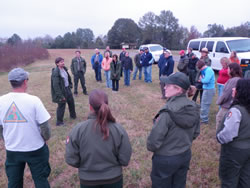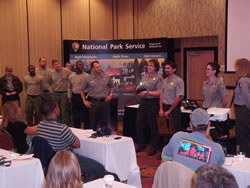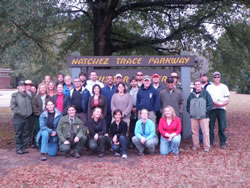
National Fire Plan Success Story
Workshop Brings Together Firefighters and Park Rangers
Natchez Trace Parkway, Mississippi
National Fire Plan - Accountability
2011

Natchez Trace FMO Shawn Nagle (second from left, facing) explains ignition tactics at Chickasaw Village, a cultural site maintained by anthropogenic fire.

Natchez Trace Superintendent Cam Sholly (center, hands on hips) uses the workshop to present awards for inter-divisional cooperation to both interpretation and fire staff.

The Class of 2010 poses in front of the Tupelo Visitor Center at Natchez Trace Parkway, a 444-mile historic road from Natchez, Mississippi, to Nashville, Tennessee.
On November 2, 3, and 4, 2010, thirty firefighters, park rangers, and public affairs officers gathered at Natchez Trace Parkway headquarters in Tupelo, Mississippi, to share success stories and tactics for educating the public about fire as an ecological process.
The meeting was the third annual fire interpretation workshop organized by the National Park Service Southeast Regional Fire and Aviation Management program and the first to be joined by participants from the NPS Midwest Region. Both regional offices, Natchez Trace Parkway, and 12 other national parks, including San Juan National Historic Site in Puerto Rico, sent staff to the workshop. Participants from the US Fish and Wildlife Service, USDA Forest Service, and county government also attended or presented.
Professor Cecil Frost of the University of North Carolina kicked off the meeting with a talk on methods for discovering an area’s pre-contact fire return interval. The “focus on ecology” continued with other classroom presentations and a half-day of field trips to learn about fire management operations and their integration with the interpretive program at Natchez Trace parkway. As one participant concluded, “It was very successful! I learned lots about fire ecology, and got wonderful ideas to take back and use from an interpretive standpoint.”
Contact: Rudy Evenson, Southeast Regional Fire Education Specialist, (404) 507-5628.